
Project Gutenberg's Cliff Dwellings of the Mesa Verde, by Don Watson
This eBook is for the use of anyone anywhere in the United States and
most other parts of the world at no cost and with almost no restrictions
whatsoever. You may copy it, give it away or re-use it under the terms
of the Project Gutenberg License included with this eBook or online at
www.gutenberg.org. If you are not located in the United States, you'll
have to check the laws of the country where you are located before using
this ebook.
Title: Cliff Dwellings of the Mesa Verde
A Study in Pictures
Author: Don Watson
Release Date: June 30, 2018 [EBook #57422]
Language: English
Character set encoding: UTF-8
*** START OF THIS PROJECT GUTENBERG EBOOK CLIFF DWELLINGS OF THE MESA VERDE ***
Produced by Stephen Hutcheson and the Online Distributed
Proofreading Team at http://www.pgdp.net

A Story in Pictures

Don Watson
Mesa Verde Museum Association
Mesa Verde National Park
Colorado
Although the Spaniards were in the Mesa Verde region as early as 1765, there is no record of their having seen the cliff dwellings. It is probable, however, that they gave the great mesa its name, which in Spanish means, “green table.” First mention of the name was made by Professor J. S. Newberry, a geologist, who climbed to the summit of the mesa in 1859. From the manner in which Newberry used the name, “Mesa Verde,” in his report there can be no doubt that it had been applied prior to that time.
In 1874, Mr. W. H. Jackson, later famous as the “Pioneer Photographer,” came into the region. Immediately upon reaching the mining camps of the La Plata Mountains, Jackson, who was making a photographic survey for the government, began to hear of ancient ruins in the Mesa Verde. Intrigued by these stories he hired a garrulous miner, John Moss, to guide him to the ruins which were said to be in the cliffs of the canyon of the Mancos River.
Entering the canyon on September 9, 1874, the party traveled slowly, carefully scanning the cliffs far above. According to John Moss the ruins would be found in caves in the sheer sandstone faces. Although many weary miles were covered no cliff dwellings were seen and by the time evening camp was made the men were beginning to lose faith in their guide. Impatiently one of the men asked Moss where the ruins were. Without looking up from the campfire Moss waved his arm at the cliff above.
Suddenly the discovery came. Just as the last rays of the sun lighted the uppermost cliff one of the men spied a small dwelling. Seven hundred feet above them it clung to the face of the cliff. The men began to scramble up the canyon wall and just as darkness fell Jackson and another man entered the little ruin. The next morning Jackson returned for his pictures. Thus fame came to the little cliff dwelling shown in the picture below. Not only was it the first Mesa Verde cliff dwelling known to have been entered by white men but it was definitely the first ever to be photographed and the first to be named. Jackson called it Two-Story Cliff House. Although Jackson discovered more small cliff dwellings in the Mancos Canyon, Two-Story Cliff House was the finest and the only one he named.

Two-Story Cliff House
This picture duplicates the first photograph ever taken of a Mesa Verde cliff dwelling. Discovered in 1874, the ruin is the first known to have been entered, photographed and named.
A year later, in 1875, another government survey party passed through the Mancos Canyon. Only a mile from Two-Story Cliff House the leader of the party, Mr. W. H. Holmes, discovered a much larger and more imposing cliff dwelling that Jackson had missed. To this ruin, shown in the picture below, he gave the name Sixteen Window House.

Sixteen Window House
This cliff dwelling, discovered in 1875, was the second to be named. The name was given because of the holes in the lower wall.
Although the small cliff dwellings of the Mancos Canyon were discovered in 1874, fourteen years passed before the largest of the cliff dwellings was found. Very little is known about that intervening period of fourteen years. There is considerable evidence that a number of prospectors and cattlemen were in the canyons of the Mesa Verde. Without doubt ruins were seen but the evidence is fragmentary and indefinite. We must move up to the year 1888, for the discovery of the greatest of the ruins.
At this point one name becomes especially prominent in this story of discovery, the name Wetherill. It is encountered in almost every tale of early exploration and it is found in a great many of the ruins, carved or written on cave walls. In 1881, Mr. B. K. Wetherill moved into the Mancos Valley and settled on a ranch a few miles north of the Mesa Verde. In the Wetherill family were five sons, Richard, John, Alfred, Clayton and Win. Addition of a brother-in-law, Charles Mason, rounds out the group of men who did the most work in discovering and exploring the ruins of the Mesa Verde.
The Wetherills were noted for their friendliness toward the Ute Indians who occupied the Mesa Verde and surrounding areas. In the early eighties the Utes began to allow them to winter their cattle in the Mancos Canyon, which bordered the Mesa Verde on the east and south. Immediately the men began to notice small cliff dwellings. They entered a number and even scratched about to see what was buried in the ruins. Rapidly their interest grew, especially when a Ute, named Acowitz, told them that in one of the canyons to the north was a cliff dwelling that was larger than all the others. His description of its size sounded unbelievable but from that time on the Wetherills had it in mind as they worked with their cattle. Once Al thought he saw it. Walking along a canyon bottom one evening he saw in the cliff, far above, the arching roof of a great cave. But darkness was coming and he did not climb up to it.
Actual details of the discovery of the greatest cliff dwelling are somewhat confusing for as the different men told the story in later years there was some variation in the minor details. On one point, however, there was no disagreement. Credit for being the first white men to enter Cliff Palace goes to Richard Wetherill and his brother-in-law, Charles Mason. Many years later Mason, in an article in the Denver Post, told of this stirring event which took place on December 18, 1888.
“In December 1888, Richard and I started out to explore. We followed the Indian trail down Chapin Mesa, between Cliff and Navaho Canyons, and camped at the head of a small branch of the Cliff Palace fork of Cliff Canyon.... We rode out to the point of the mesa.... From the rim of the canyon we had our first view of Cliff Palace, just across the canyon from us. To me this is the grandest view of all among the ancient ruins of the Southwest.”

Cliff Palace
On December 18, 1888, two cowboys discovered Cliff Palace, the largest of the cliff dwellings. The picture duplicates the view they had from the opposite canyon rim.
After first sighting Cliff Palace from the opposite canyon rim, the two cowboys decided to enter the great cliff dwelling. Again we go to the words of Charles Mason for this part of the story.
“We rode around the head of the canyon and found a way down over the cliffs to the level of the building. We spent several hours going from room to room, and picked up several articles of interest, among them a stone axe with the handle still on it. There were also parts of several human skeletons scattered about.”
When archeologists excavated Cliff Palace twenty years later it was impossible to visualize the ruin as it had been at the time of discovery. Time after time it had been dug into by the early explorers and no part was undisturbed. For a picture of the ruin as it was on the day of discovery we must again refer to the story told by Charles Mason. While some of his ideas would be hard to support his impressions as he first walked through the greatest of all cliff dwellings are of interest.
“The final tragedy of the cliff dwellers probably occurred at Cliff Palace. There is scarcely room to doubt that the place withstood an extended siege. In the entire building only two timbers were found by us. All of the joists on which floors and roofs were laid had been wrenched out. These timbers had been built into the walls and are difficult to remove, even the little willows on which the mud roof and upper floors were laid were carefully taken out. No plausible reason for this has been advanced except that it was used for fuel.
“Another strange circumstance is that so many of their valuable possessions were left in the rooms and covered with the clay of which the roofs and upper floors were made.... It would seem that the intention was to conceal their valuables so that their enemies might not secure them.... There were many human bones scattered about, as though several people had been killed and left unburied....
“It seems to me there can be no doubt that the cliff dwellers were exterminated by their more savage and warlike neighbors, the men being killed and the women being adopted into the tribe of the conquerors, though in some cases migrations may have become necessary as a result of drouth or pressure from outside tribes.”
Mr. Mason did not realize how near the truth he was when he suggested that, “migrations may have become necessary as a result of drouth or pressure from outside tribes.”

Cliff Palace
When the cowboys entered Cliff Palace on December 18, 1888, the great ruin did not look as it does in this picture. This view, taken from the south end of the ruin, shows its present condition. In 1888, the courts, passageways and rooms were deep with the rubble of fallen walls and collapsed roofs. This debris was removed in 1909, and only the standing walls remain today.
After discovering Cliff Palace the two cowboys decided to separate and search for more ruins. Mason rode off to the north while Wetherill went more to the west. After riding a short distance Wetherill came to the rim of a small canyon. Riding around the head of the canyon and looking back under the eastern cliff he saw another great cliff dwelling, pictured below. Since it was late afternoon he did not enter the ruin but returned to the camp near Cliff Palace.
While not as large as Cliff Palace, this second cliff dwelling, which they later named Spruce Tree House, was in a better state of preservation. Many of its walls still stood at their original height, touching the roof of the cave. Several of the rooms had their original ceilings. Spruce Tree House has since proved to be the best preserved large cliff dwelling in the Mesa Verde.
At the head of the canyon only a hundred yards from Spruce Tree House was a wonderful spring. Because of the fine flow of water the cowboys often camped there. Later park headquarters were located there and the first road came directly to it. It was because of this permanent water supply that all modern developments were located in the Spruce Tree House area.
Spruce Tree House was one of the cliff dwellings excavated by the first archeologist to work in the Mesa Verde. In 1891, less than three years after the discovery, the Swedish archeologist, Baron Gustav Nordenskiold, was excavating in the cliff dwellings.
Nordenskiold, a member of the Swedish nobility, had read of the Mesa Verde ruins and had decided to excavate some of them. In July 1891, he arrived at the Wetherill ranch and hired John Wetherill as his guide and foreman. Three more men were hired as laborers and for four months the group excavated in the cliff dwellings.
Spruce Tree House bears Nordenskiold’s inscription, “Number 1 House.” Cliff Palace bears the inscription, “No. 2,” and in all, twenty-two ruins bear numbers left by Nordenskiold.
The archeological specimens recovered by Nordenskiold were taken to Sweden but at the present time are in the National Museum, in Helsinki, Finland. In the collection, as cataloged today, are about 600 specimens. While it is a good collection it does not deserve the fabulous reputation it has acquired. Although Nordenskiold reached the Mesa Verde in 1891, the finest things had already been taken out by the cowboys. His collection contained a number of outstanding specimens but in its entirety did not compare with the collections taken out by the cowboys themselves.

Spruce Tree House
Spruce Tree House was the second large cliff dwelling discovered by the cowboys. Richard Wetherill saw it from the canyon rim on the same day that he and Charles Mason found Cliff Palace. His view on that wintry day of December 18, 1888, probably was much like this.
After discovering Cliff Palace and Spruce Tree House, Richard Wetherill and Charles Mason returned to their camp. The next morning they started off to visit Spruce Tree House, which only Richard had seen the day before. As they rode across the snow covered mesa they misjudged their direction and bore too far to the south. Coming to the rim of a deep canyon they found, not Spruce Tree House, but another large cliff dwelling.
Although not as large as the two they had found the day before it was still much larger than any they had seen previously. The outstanding feature of the ruin was a tall square tower, a four-story structure that rose against the cliff. Because of it they later named the ruin Square Tower House.
The two men now began to realize the importance of their discoveries. During the past few years they had seen many small ruins along the Mancos Canyon to the south. Now they had pushed up the canyons to the north and in the space of two days had found not only the ruin Acowitz had called the “greatest cliff dwelling,” but two more large ruins. As they sat on their horses above Square Tower House they could see that off to the north and west were many more canyons. Surely more of the mysterious structures awaited discovery.
Filled with a desire to tell others of their surprising discoveries they returned to the Wetherill ranch and spread the news of the great ruins they had found. Immediately John Wetherill decided to visit Cliff Palace. With three other men he set out and only four days after the discovery the men entered the ruin and began to excavate.
Near the south end of the ruin a kiva was in perfect condition except that the roof was missing. Stretching a piece of canvas over it the men moved in and for three weeks the ancient ceremonial room served as living quarters as they excavated the great cliff dwelling. This was the beginning of serious excavation by the cowboys. The discovery of the large ruins made them feel that the recovery of articles left behind by the Indians might be a profitable business. As Charles Mason stated later in referring to one of their expeditions, “This time we went at it in a more business-like manner. Our previous work had been carried out more to satisfy our own curiosity than for any other purpose but this time it was a business proposition.”
On this first expedition the men kept no record of what they found. In later years two things stood out in John Wetherill’s memory. Throughout the ruin they found a profusion of baskets and in the low room in the rear of the cave they found fourteen mummies.

Square Tower House
The third large ruin discovered by Richard Wetherill and Charles Mason was Square Tower House. The tower which gave the ruin its name is the tallest structure in the Mesa Verde, one wall measuring thirty-three feet in height. In this ruin, of seven kivas and about seventy rooms, two of the kivas have remarkably well preserved roofs.
Within a short time after the discovery of the major ruins a large number of men were digging in the cliff dwellings of the Mesa Verde. The Wetherills were able to sell several collections, one for $3000, and word spread that digging was profitable.
That the ruins suffered greatly from the work done during the early years is everywhere evident. Below is Long House, probably the saddest example of what careless excavation did to the ruins. Long House was, without doubt, the second largest cliff dwelling in the Mesa Verde, rivaling Cliff Palace in size. Now little remains standing. But careful study of foundations, broken bits of masonry and the outlines of rooms on the cave walls indicates that the cave was once full of high structures. The great mass of stones that can be seen sliding down into the trees all across the front of the cave is an indication of the amount of masonry that once stood in the cave. Tales have come down to us indicating that dynamite was used by some of the early explorers in opening up the ruins. Dynamite fuse found in Long House lends support to these stories.
The work of some of the diggers was careless and ruthless. They had no consideration for the ruins for their only thought was of the sales value of the artifacts recovered. An indication of this can be seen in the fact that a banker in a nearby town “grub staked” men to dig in the ruins. Supplying them with food and equipment he received a percentage of their profits from the sale of artifacts.
The vast wealth of material taken from the ruins was widely scattered and much of it has disappeared. Of all those who excavated in the Mesa Verde during the early years probably only the Wetherill brothers kept records on what they found. Most of their collections were sold to museums and the Wetherills were encouraged by the museums to keep careful notes. These collections, even though they may now be in distant parts of the world, have value because of the records the men kept.
In 1889 and 1890, a writer named F. H. Chapin spent several weeks in the Mesa Verde traveling with the Wetherills. The extent of their excavations is indicated by some of the statements in his famous book, “The Land of the Cliff Dwellers.”
“Up to March 14, 1890, they had examined in all one hundred and eighty-two houses.... They visited one hundred and six houses in Navaho Canyon alone....”
The thoroughness with which the ruins were excavated can be seen by a statement made by Charles Mason in writing about one of their collecting trips. “In spite of the fact that all of the cliff dwellings had been worked two or three times, we succeeded in making a very good showing.”

Long House
Long House is one of the many ruins in the remote western part of the park. It was once the second largest cliff dwelling in the Mesa Verde. Today little is left for much of it was demolished by the early explorers. Fifteen kivas can be counted but because of the tumbled condition it is impossible to estimate how many rooms it once contained. One early writer who saw Long House in 1890, stated that it was the largest cliff dwelling that had been discovered in this region. Perhaps at that time much more of Long House was standing.
The larger ruins of the Mesa Verde were discovered in 1888, and for eighteen years they were without protection. Anyone who wished to could excavate in them and since there was a ready sale for the artifacts a large number of men engaged in commercial excavation. The ruins suffered greatly during this period for there was no realization that the area would ever be accessible to the general public.
In 1906, through the efforts of interested people, a portion of the mesa was set aside as Mesa Verde National Park and since that time the ruins have been protected. A superintendent and the first rangers reached the new park in 1907, and the period of commercial excavation came to an end.
At that time there was no road and the park could be reached only by a ride of thirty miles on horseback. In spite of this, visitors began to come and it soon became apparent that in time there would be heavy visitation. Equally apparent was the fact that the ruins were in no condition to receive visitors. Weakened by centuries of neglect and further weakened by the careless work of the early explorers many of the ruins were in poor condition. They could not long survive the impact of the thousands of visitors who would begin to arrive as soon as the first road was built. The answer to this problem was excavation and repair of ruins that were to be visited by the public.
In 1908, Dr. J. Walter Fewkes, of the Smithsonian Institution, excavated Spruce Tree House and the picture below shows the ruin as it looks today. First the ruin was cleaned out. When the work began, the courts, passageways, and ground floor rooms were filled, sometimes to a depth of several feet, with fallen stones, caved roofs and trash. As this debris was removed, only a few articles of value were found for the early excavators had been thorough in their work. The repair work consisted simply of strengthening the weak sections so there would be no further deterioration. Crumbling foundations were strengthened; leaning walls were braced; cracks were filled with adobe mortar. In all the work there was no thought of restoration for too much modern work would destroy the spirit of the ancient ruin.
In his report on the work in Spruce Tree House, Dr. Fewkes stated, “The intention of the author has not been the reconstruction but the repair of Spruce Tree House. Walls in danger of falling, especially those that have suffered a thrust from the perpendicular, have been so treated as to prevent their falling. No radical reconstruction of the rooms has been attempted; the walls have not been built up, but the skylines remain practically as they were before the excavations were begun.”

Spruce Tree House
The view of Spruce Tree House shows the ruin after excavation. In 1908, the debris was cleaned out and necessary repairs were made. At the time of excavation, Dr. Fewkes counted eight kivas and 114 rooms. He estimated, however, that it had once contained at least 140 rooms. Large sections of the ruin still stand at their original height and several rooms have their original roofs.
Study of the cliff dwellings of the Mesa Verde has revealed a surprising similarity of architecture throughout the area. The structures were the work of a single tribal group and a definite pattern was followed by all the members. Some cliff dwellings were small, others very large, the size depending entirely on the size of the cave. The area covered by the tribe embraced the Four Corners sections of the present states of Colorado, Utah, Arizona and New Mexico. But in all the cliff dwellings constructed by the members of this far-reaching tribe certain architectural features are commonly found.
Below are shown some of the details that characterize Mesa Verde architecture.

No. 1.
Most of the doors were small rectangular openings, usually two or three feet above the floor. The average dimensions of forty doors measured in Cliff Palace were: height, 25 inches; width, 16 inches.
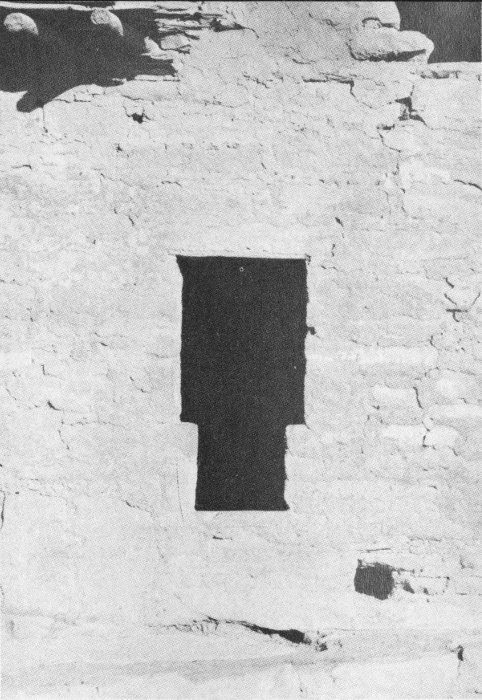
No. 2.
T-shaped doors are less common than the rectangular openings, some ruins having many, others very few. The T-door is simply a standard door with the added notch at the bottom. It is a much more convenient door for if the hands are placed on the two ledges it is quite easy to fold the legs and swing through the opening.
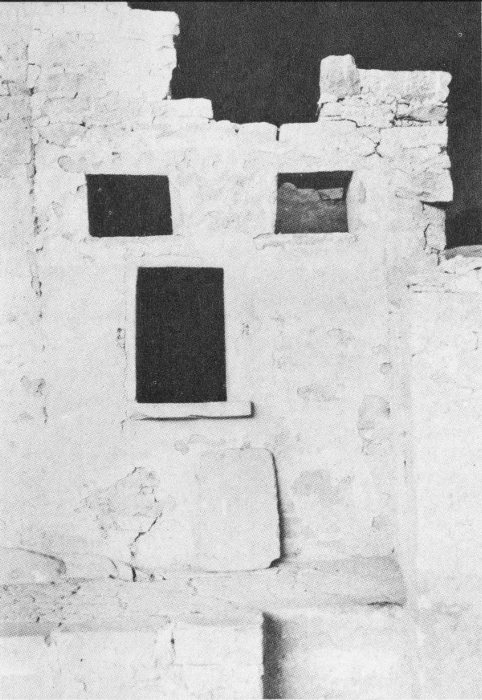
No. 3.
Windows are not common in Mesa Verde ruins. When present they are small, often little more than peepholes. Note the door slab leaning against the wall.

No. 4.
Doors were closed with thin sandstone slabs. A small stick set into the masonry under the lintel kept the door slab from falling through.
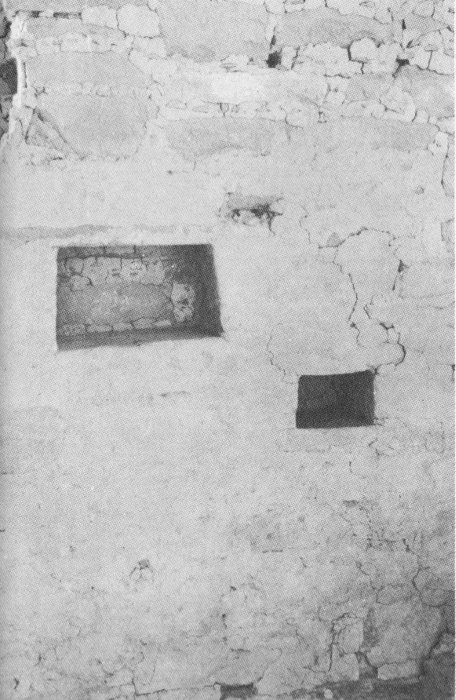
No. 1.
These small built-in shelves are very common on the inside walls of the rooms. Evidently they were for the storage of household articles.
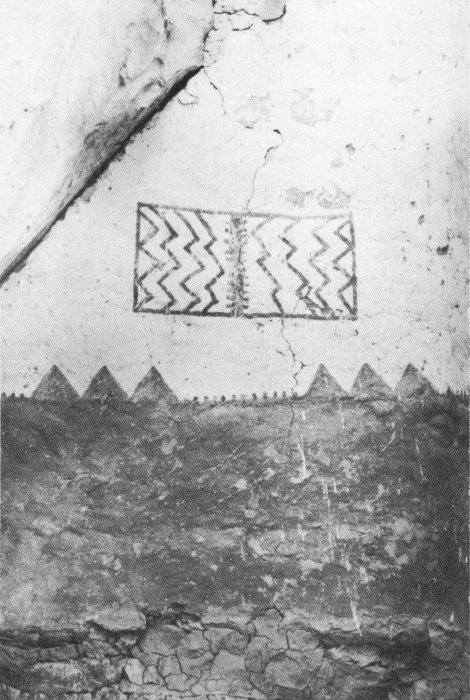
No. 2.
Plastered walls are extremely common, the plaster being made of clay of various colors. The wall shown here has orange-red designs on a white background. The three-triangle design is found more often than any other design element, being especially common in kiva paintings.
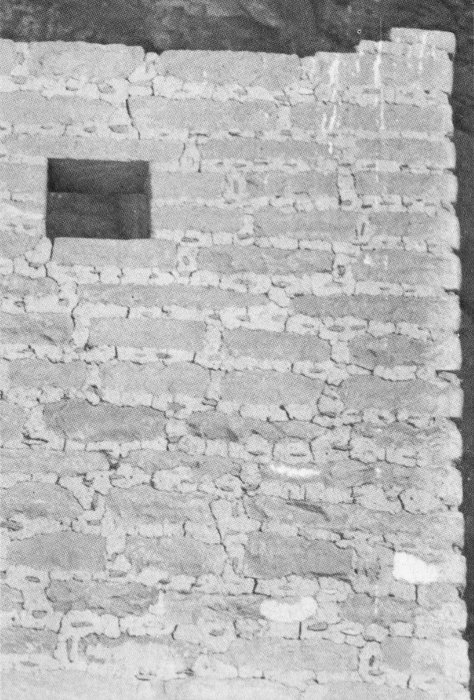
No. 3.
Typical Mesa Verde masonry is made of rather large, well shaped stones, set in thick layers of adobe mortar. Small stones, or spalls, were forced into the mortar to compact it in the joint.

No. 4.
Masonry in the cliff dwellings often exhibits surprisingly smooth surfaces and clean sharp lines. The stonework in this wall is of the highest quality.

No. 1.
Roofs of the rooms in the cliff dwellings were constructed of poles and adobe. The covering layer of packed adobe was from three to five inches thick and was smooth and hard.
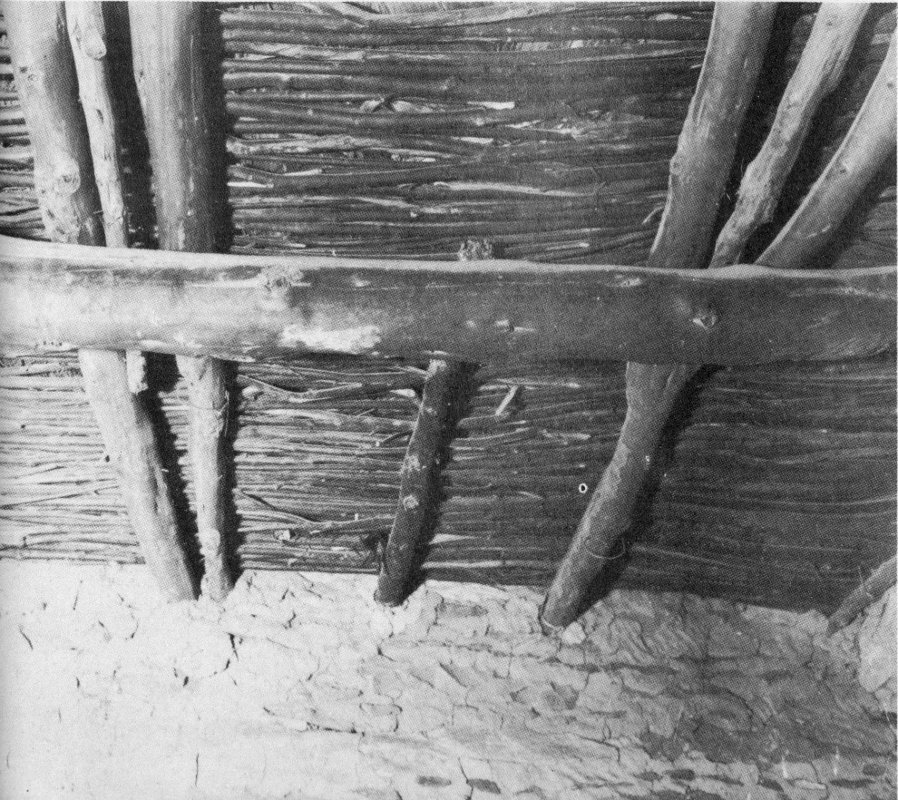
No. 1.
Logs, poles and withes of various sizes were used in constructing the support structure for the roofs. Usually one or two heavy timbers spanned the room. Smaller poles were placed at right angles to the heavy joists and were in turn covered with a solid layer of slender withes or split poles. Addition of the layer of packed adobe completed the roof.
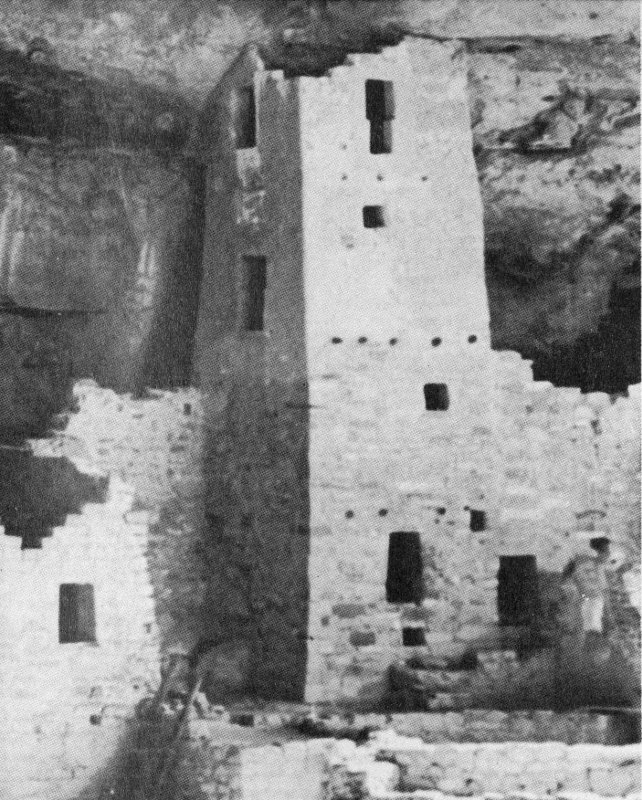
No. 2.
Square towers, two to four stories in height, were common in the cliff dwellings. The builders, however, were not actually constructing “towers,” as we think of them. They were simply building living rooms one on top of another in order that additional families might enjoy the security offered by the caves. Sometimes these tall structures appear as towers merely because adjacent high structures have fallen.

No. 3.
Tapered, round towers are not common in the cliff dwellings. Round rooms are occasionally encountered, but of these carefully constructed, tapering round towers there are only a few. No special use can be suggested as nothing unusual has been found in them. The round tower pictured is in Cliff Palace. The faces of all the stones are curved to fit the circular shape.
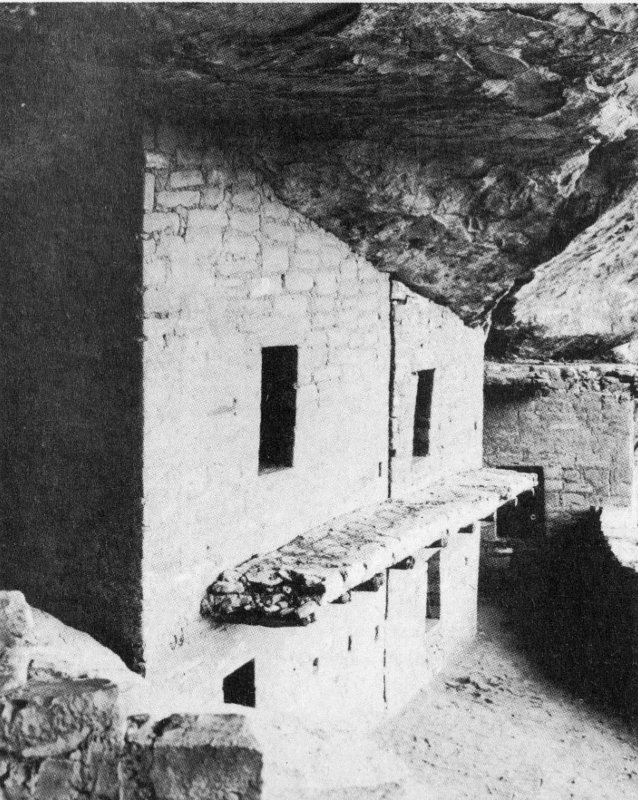
No. 2.
These narrow platforms, or balconies, were often constructed under second, third and fourth story doors. Sometimes they were merely small platforms but often they were long walks connecting upstairs rooms.

No. 3.
Masonry columns are not at all common in the cliff dwellings. Possibly this construction feature was just coming into use for only three have been found. The column pictured is in Spruce Tree House. It rests on a first-floor wall and supports a third-story room.
The term “living room,” as we use it today, is really not a good term for the rooms in the cliff dwellings. Actually these were, for the most part, sleeping and storage rooms. Probably few of the activities of daily life took place in them. The real “living space” was the great open areas in the villages, the kiva courts and the terraced housetops. The cave itself served as a roof over the entire village and the people probably spent most of their active life outside the rooms.
Most of the rooms were small and dark. In the pictures below the small size of the doors is clearly evident and the few windows were little more than peepholes. Very few of the rooms had fires inside so the light was poor. Weaving, sewing, pottery making, and such activities could not have been carried on inside the rooms.
For the most part the rooms should be considered as sleeping and storage rooms. If an adult could stretch out at full length on the floor the room was large enough for sleeping purposes. If it were too small for normal sleeping it served as storage space for food supplies and family possessions.
In the winter there may have been more crowding into the rooms. However, it must be remembered that fires were seldom built in the houses so there was little warmth unless a person actually bundled up in skins and blankets and went to bed. The fires were built in the courts and on the open roofs and in cold weather the people probably huddled about them.

This upper section of Double House is typical of the small, high caves that are so common in the Mesa Verde. The rooms were very small and the roof so low that a person could not stand upright. Only a narrow ledge was left between the houses and the sheer cliff. The kivas were at the foot of the cliff and most of the activities may have been carried on there.
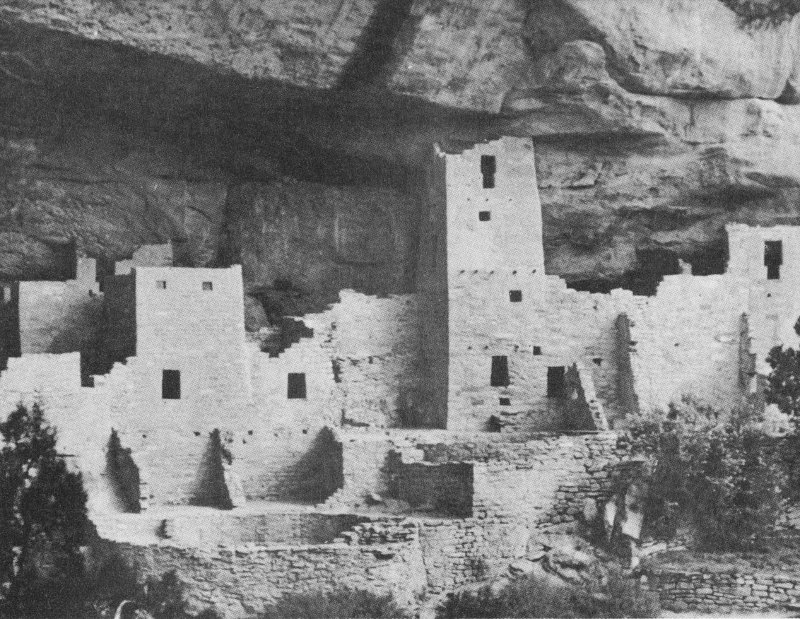
These structures at the south end of Cliff Palace were from one to four stories in height. The rooms were built one on top of another so more families could enjoy the security of the cave. In front of the houses was a row of kivas. The kiva roofs and the house roofs provided space for the activities of daily life.

In constructing their houses the Indians did not try to change the cave to fit their needs. Notice how the house walls were made to fit the irregularities of the cave. Working with tools of stone they seldom tried to cut into the cave walls.
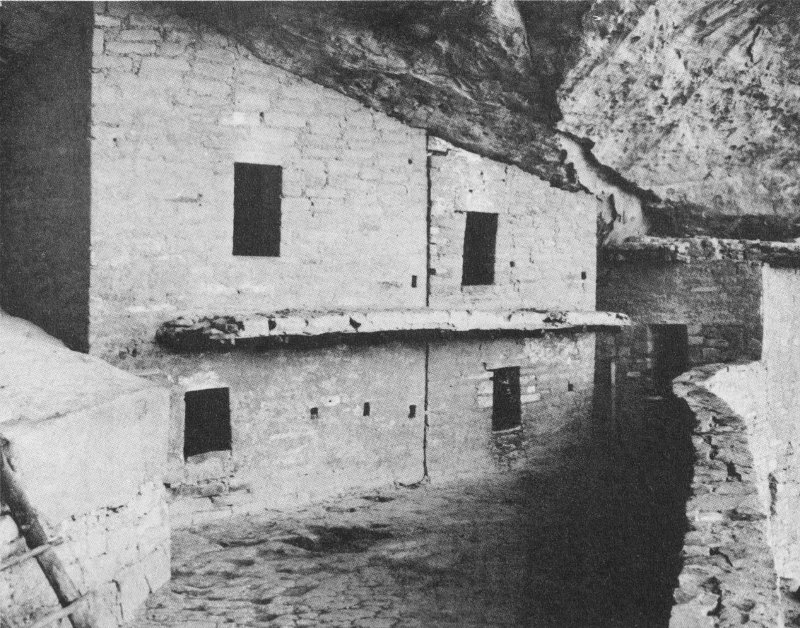
The north end of Balcony House is an outstanding example of ancient architecture. The rooms are much larger than usual and the masonry is of the highest quality. The balcony is the finest in the Mesa Verde. In front of the houses was a large court that was shared by the various families. The low parapet wall at the right protected the people, especially the children, from the high cliff in front of the cave.
To the person who views a cliff dwelling for the first time the most interesting feature is the underground ceremonial room. Modern Hopi Indians call these rooms “kivas,” and this term is commonly used. The kivas in Mesa Verde cliff dwellings developed from earlier pithouses and exhibit a high degree of standardization. Although there are occasional variations almost all Mesa Verde kivas contain the same standard features. Kivas are thought to have been used chiefly by the men and served as combination ceremonial rooms, club rooms, council chambers and workshops.

No. 1.
Mesa Verde kivas were underground rooms, usually circular or roughly circular in shape. The log and adobe roof covered the room completely except for the small hatchway in the center. Secrecy was thus provided for events that took place in the kivas. The hatchway in the roof served not only as an entrance but also as a smoke hole for the small fire that burned below. Usually the hatchway was the only entrance but a few kivas had side tunnels leading to nearby rooms. As will be explained later, the kiva roof was one of the most important areas in a cliff dwelling for it formed a large open court. Most of the daily activities of the people took place in these courts. The kiva pictured is in Spruce Tree House. The roof has been reconstructed to show the original appearance.

No. 2.
The kiva pictured here contains all features common to the kivas of the Mesa Verde ruins. Warmth and light were provided by a fire that burned in the large pit in the floor. The hatchway in the roof served as a smoke hole. As the smoke and warm air rose through the hatchway, fresh air was drawn down the ventilator shaft. The small hole at the top of the picture is the opening of a vertical ventilator shaft which extended down to the rectangular opening at the base of the wall. Between the firepit and the ventilator a stone slab served as a deflector, keeping the fresh air current from blowing across the fire. The low shelf around the kiva wall served as storage space for articles of all types. The low pilasters on this shelf, usually six in number, supported a log and adobe roof. Note that the shelf is wider on the far wall, next to the ventilator shaft. The use of this deeper recess, which was usually more or less toward the south, is not known. In the back wall of this recess were two small niches which served as storage space for small articles. The one remaining feature is the small hole in the floor in front of the firepit. This same feature exists today in the kivas of some of the present-day Indians. It is called the “sipapu” and serves as a symbolic entrance to the Mother Earth.
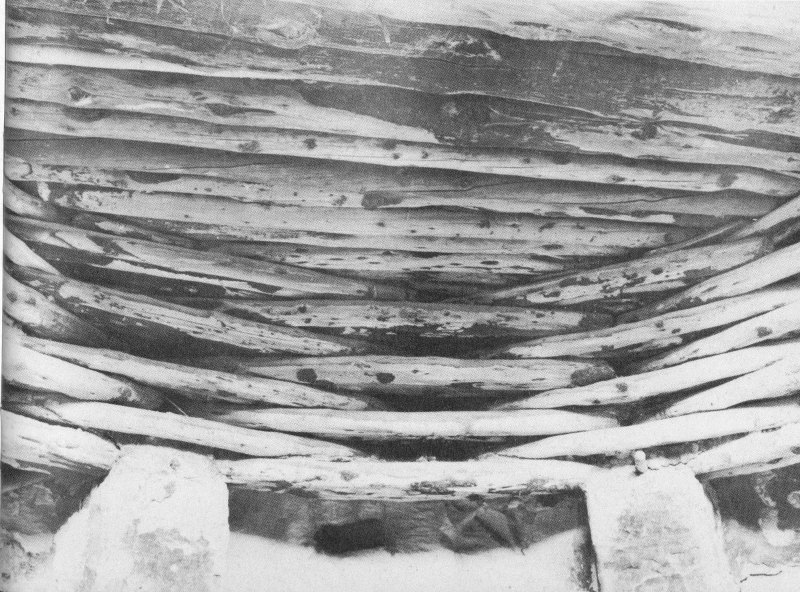
No. 1.
The kiva roof was supported by an ingenious framework of cribbed logs. As was mentioned above, six low stone pillars usually were constructed on the bench that encircled the kiva. Short logs were laid from pillar to pillar forming a circle of logs entirely around the room. A second circle of logs was placed on the first, with the logs cutting the angles in the first set. Another and another circle of logs was added—in the kiva pictured there were eight layers of logs altogether. As the circles rose they grew smaller and a dome effect was created. Finally logs were placed across the opening and a covering layer of adobe completed the roof. While this was an ingenious method, the roofs had a serious weakness. The entire weight of the roof rested on the first layer of logs. When one of these logs broke, the entire roof usually collapsed. As a result few of the kiva roofs are in place today. The one pictured is in Square Tower House.
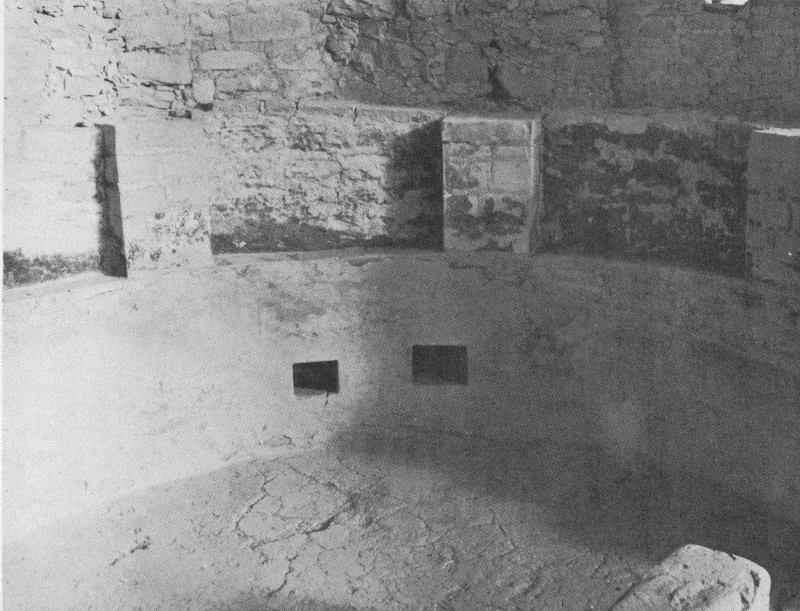
No. 2.
This kiva, which is in Cliff Palace, exhibits masonry of the highest quality. The smooth, sharp corners of the three pilasters, the true rectangular wall niches, the smooth plaster and the tamped adobe floor were the work of skilled craftsmen.
It is impossible to picture life in one of the large cliff dwellings unless the architectural unit shown below is taken into consideration. This small section of Spruce Tree House consists of a kiva partially surrounded by a group of rooms. This relationship of kiva and houses is so common in the larger caves that it must indicate deliberate planning on the part of the builders.
In Spruce Tree House there are six of these kiva courts, almost identical to the one shown here. In each case the kiva with its flat open roof is partially or completely surrounded by houses.
In considering the kiva court shown below it is quite possible that the houses were occupied by a group of closely related families, perhaps a small clan. In the high rear wall nine doorways can be seen. Each door opened into an individual room that had no side or rear doors. In these small, cell-like rooms the people slept and stored their possessions.
The active life of the people from these houses was in the open court and on surrounding roofs. There was ample room for all and it was here that they cooked, ate, worked, and played. The overhanging cave roof sheltered the entire village from the elements and there was little need for the people to use the small dark rooms except at night. There was little privacy for individual families; probably all of the residents of this court area lived together like one very large family.
About twenty rooms seem to have opened into this kiva court. Certainly it should not be considered that there were that many individual families. But it is evident that a large number of people occupied the rooms and shared the open court. In the left foreground can be seen the hatchway of a second kiva. The roof of this kiva formed another court which was surrounded by another group of rooms much like those shown at the right.
The kiva itself should not be tied too closely to the clan or group of families living around it. Customs in some of the present-day Indian Pueblos lead to the belief that a kiva was used by a religious society and men from other parts of the village and other clans could have been members of this ceremonial group. The kiva may have belonged to the clan which lived around it and may have been taken care of by the men of this clan. But its ceremonies would have been conducted by a religious society to which belonged men of various clans.

Kiva Court in Spruce House.
It is impossible to look at the cliff dwellings without wondering why the Pueblo Indians chose to build their homes in the cliffs. A few of the ruins are in large, open, airy, easily accessible caves, that to the casual observer might seem like rather decent places in which to live. But most of the caves are not of this type. The majority are high on the cliff faces—many are merely narrow high ledges on which a few rooms could be perched.
For many centuries the Pueblo Indians of the Mesa Verde area lived on the open mesa tops and in the broad fertile valleys. They were a settled agricultural group, highly skilled in all their arts and crafts. Then, rather suddenly, they left their pleasant pueblos and moved into the caves. Within a short time there were few Indians left out in the open. What caused this sudden change in their way of life? In order to answer this question it is necessary to consider the entire background of the Pueblo Indians of this area.
The earliest evidences of these people indicate that they were well established in the Mesa Verde region shortly after the birth of Christ. Originally a hunting people, they had received corn and squash from more southern neighbors and were turning to a settled agricultural life.
At first they seem to have had no houses so, at least for part of the year, they occupied the caves. After a time they began to experiment with simple pithouses. When substantial houses had developed they left the caves and built their villages in the open. For many centuries they lived in the open valleys and on the broad mesa tops. The population grew and the tribe spread over a wide area. The architecture developed steadily and by the twelfth century the people were living in hundreds of pueblos, constructed of stone and adobe masonry.
Late in the twelfth century the people began to move and the population began to diminish. Some of the people left the area, drifting off to the south. The rest began to search for defensive locations for their villages. In the Mesa Verde the villages were moved to the caves of which there were many hundreds in the numerous canyons. By the early part of the thirteenth century most of the Indians had moved to the caves and during the last few generations the people were in the Mesa Verde it appears that few lived in the open.
There can be little doubt that the movement to the caves was caused by the arrival of an enemy group. In many parts of the Southwest, the same thing happened. Evidently some nomadic group, perhaps the earliest of the Apaches, came into the area and began to harass the Pueblo Indians. In the interest of health the peaceful farmers began to build their homes where they could defend them against marauders.
After living in the open for many centuries the Pueblo Indians of the Mesa Verde moved to the caves and constructed the cliff dwellings. There can be little doubt that this move was prompted by a desire for defensive locations.

Double House, part of which is shown here, is an excellent indication of the Pueblo Indians’ desire to utilize the caves. The ruin is in seven sections, not all of which are shown, and indicates a desire to build in easily defensible places, no matter how small or difficult of access they were. All together, Double House has about seventy rooms, with several kivas along the base of the cliff.
The majority of the cliff dwellings are in locations more or less like those shown below. Villages like these could easily have been defended against raiders armed with bows and arrows.
From a modern viewpoint a cave might not appear to be a safe place for a home. All thought of modern warfare must be forgotten, however, and ancient methods must be kept in mind. When it is considered that the cliff dwellers lived in bow and arrow times it is not difficult to see the cliff dwellings as defensive structures. Because of the location and the type of construction, they served as excellent forts against bow and arrow attack.
Some of the villages were at the base of the cliff and were easily accessible. But the inhabitants of such towns had to defend only the front of the cave and their thick walls would have suffered no damage from arrows. The men of a large village, such as Spruce Tree House or Cliff Palace, could have repulsed a small raiding party without too much difficulty. The small high villages were comparatively safe because of the difficulty of access. Some caves were reached by ladders; others by toe-holds cut in the cliff. In many of the small high cliff dwellings no evidence of a trail can be found. They were too high for ladders, the cliffs were too steep for toe-holds, and no ledges led to them. One can only suppose they were entered by means of ropes.
Although the cliff dwellings were excellent defensive structures they were weak in one respect—the water supply was outside the caves. Of the hundreds of cliff dwellings probably not more than a score had springs within the cave. In almost every case the women carried water from nearby, or distant springs. In all probability the people did not have to worry about actual sieges. The enemy people were hunters who traveled in small bands. Word of a raiding party would have spread quickly for there were few isolated villages where the people could not call to the next village and so on along the canyon. It was possible to call across even the largest canyons and warnings would have traveled well in advance of the raiders.
In their large jars the villagers could have stored considerable water and with their supplies of food could have withstood short sieges. Actually the raiders would have starved out first for being hunters they could not have stayed long in one place. And to lay siege to one village might have invited concerted action by the residents of several nearby towns.

Casa Colorado.
This village of about twenty rooms received its name because of the reddish tint of its walls. Although the cave is not high, it could be entered only at the right side. Defensive walls were constructed to guard the entrance.
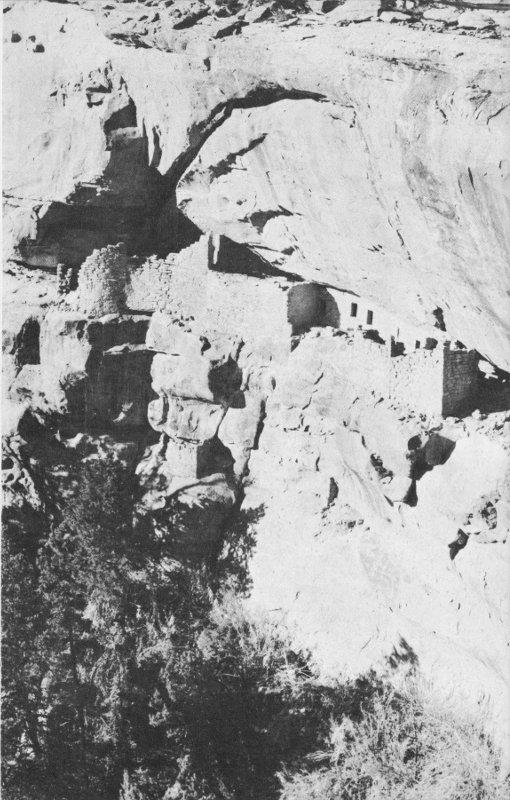
Ruin No. 12.
Although this cliff dwelling has only twenty rooms, it contains five kivas. High on the cliff face, the village was entered by means of a narrow ledge at the right.
It is difficult to discuss the cliff dwellings without dividing them into groups according to size. The hundreds of ruins vary from one room to over 200 rooms. Only by dividing them into groups is it possible to show the relative abundance of ruins of various sizes. The table given below is of no real importance. It is merely one person’s way of dividing the ruins by size for discussion purposes. One could just as well divide them into three groups or ten groups. And the number of rooms selected for each group is only of relative importance. The numbers merely provide a yardstick for discussion purposes. For convenience only, the hundreds of cliff dwellings will be divided into the following five size groups:
| Very large | more than 100 rooms. |
| Large | 51 to 100 rooms. |
| Medium | 21 to 50 rooms. |
| Small | 6 to 20 rooms. |
| Very small | 1 to 5 rooms. |
Before considering the relative abundance of the ruins in the various groups it would be well to consider the total number of cliff dwellings in the Mesa Verde. The answer is, of course, that no one knows and probably no one will ever know. There are too many canyons and too many ruins!
In 1891, Richard Wetherill told Nordenskiold, the Swedish archeologist, that there were more than 500 cliff dwellings in the Mancos Canyon and its side canyons. Many more were discovered later. Certainly no one knew the ruins of the area better than the Wetherills. As Charles Mason stated, their search for ruins was a “business proposition.” If Richard Wetherill felt there were more than 500, it probably is a safe figure to use. How many “more,” is of little importance.
Probably not more than four of the Mesa Verde cliff dwellings fall into this group. The difficulty is that of all the cliff dwellings only eight have been completely excavated. It is impossible to make even a fairly accurate count of the rooms in a large unexcavated ruin for the mass of debris often hides the lower walls.
Cliff Palace, with its 23 kivas and more than 200 rooms is, of course, the largest, but originally Long House may have been a close rival in size. Long House was so badly knocked about by the early explorers that it is impossible even to estimate how large it once was. Certainly it was second in size. The other two that fall into this group are Spruce Tree House and Spring House. Excavation and careful counting of rooms would perhaps add one or two more to this group but at present one can not be certain.

When the matter of size is considered, Cliff Palace, of which a portion is shown here, heads the list. Dr. Jesse W. Fewkes, who cleaned out and repaired the ruin in 1909, counted 23 kivas and over 200 rooms. Originally it contained many more rooms for several high sections had fallen before excavation.
It is difficult to suggest how many of the cliff dwellings fall into the 51-to-100-room group. There are several reasons for this.
First of all, as has been suggested, it is difficult to count the rooms in an unexcavated ruin. What was once a large ruin may be little more than a mass of fallen stones. Evidences of upper stories often have disappeared entirely. If one enters a cave and counts the rooms that are in evidence it is usually safe to assume that many more have disappeared completely.
Another difficulty is that little of the Mesa Verde has been explored in modern times. The remote parts of the mesa, over half of which is Ute Indian Reservation, have had little exploration since the days of the cowboys. Hundreds of the ruins have not been entered in modern times. It is doubtful if any living person has been in one hundred of the Mesa Verde cliff dwellings. Distant views have been had of a great many but only a small number in the more accessible areas have been entered.
Thus it is difficult to estimate the number of ruins that contained from 51 to 100 rooms. Probably there were a dozen—perhaps there were twice that many. A more definite answer must await further exploration.
In this discussion of the large ruins one thing becomes evident. Only a small portion of the people lived in the larger villages. The bulk of the population was in the smaller villages, of which there were several hundred.

Kodak House
Kodak House is an excellent example of a large cliff dwelling. It is also an excellent example of the ruins that were badly treated by the early explorers. Large portions of this ruin were pushed out of the cave by the men who were digging for articles of value. Kodak House appears to have contained at least seventy rooms originally.
It is impossible to make even a close estimate of the number of ruins in this 21-to-50-room group. They are to be found in all the canyons and only an exhaustive survey will reveal the actual number. Perhaps there are a hundred of them—probably many more.
As one explores the canyons and enters more and more of the ruins a surprising fact becomes evident. Ruins which at first glance seem small can turn up a surprising number of rooms. A distant view across a canyon may reveal only a few broken walls. Upon gaining access to the cave, perhaps by swinging down on a long rope, the first glance still reveals little. Then, as the ruin is studied carefully, it begins to grow.
The only evidence of a three or four story structure may be rows of small holes in the cliff where the ends of roof beams once rested. A thin line of plaster running up the cliff may be the only indication of a high plastered structure that once stood there. Sometimes, fifteen or twenty feet up on a cave wall, a bright red spot may be seen on the sandstone. This is mute evidence that a structure once stood there for the red discoloration of the sandstone was caused by a small cooking fire that once burned on a third or fourth story roof.
Thus the difficulty of estimating the number of ruins of any particular size is evident. In all probability, not half of the canyons have been explored to any extent by archeologists. Perhaps not more than one-third of the cliff dwellings, especially the small high ones, have been entered by anyone since the days of the early cowboys.
A great deal of exploration and careful study will be necessary before the actual archeological wealth of the Mesa Verde will be known.

Balcony House
Balcony House, shown here, is an excellent example of the medium-sized cliff dwellings. In size it is near the top of the group for it contains two kivas and about forty-five rooms. In several respects Balcony House is one of the outstanding ruins and is the favorite with most visitors. Its location on the face of the cliff gave it outstanding defensive possibilities. The only entrance was a narrow ledge that ran about 400 feet along the face of the cliff. At one point the trail passed through a narrow crevice. This the Indians blocked with high walls and final access to the village was through a narrow crawl tunnel.
The outstanding feature of this ruin is an excellent spring in the back of the cave. With this supply of water and their strong defenses, the people had little to fear from enemy raiders.
Below are four ruins that fall in the medium-sized group. They contain from twenty-five to forty rooms and are typical of the scores of ruins of this size that are to be found in the many canyons. In some of the ruins pictured few structures remain standing but careful search reveals evidence of the many rooms that have disappeared. These were once bustling little agricultural towns of a few dozen people. Without doubt the peaceful farmers prized the security of their high-flung villages.
As more and more of the ruins are entered and studied, one fact becomes increasingly evident. Of the entire population of the Mesa Verde, relatively few people lived in the larger cliff dwellings. For every cliff dwelling of more than fifty rooms there were scores of smaller villages.
The larger towns may have been important centers in some respects. They no doubt offered excellent trading possibilities for the men from the small towns. Perhaps a man from one of the small villages had a fine tanned buckskin that he wished to trade for jewelry. Certainly his best business opportunities would have been in one of the larger towns like Long House or Cliff Palace. When an important ceremony was held in one of the big communities, probably men flocked in from all the nearby small villages to enjoy the event. They came not only to view the public portions of the ceremony but to participate in the feasting, gossiping, trading and gambling that accompanied it.
If the large communities were important to the people of the small towns it probably was only in the ways mentioned above. They did not look to them for leadership for certainly there was no union among the people. Probably there were never more than a few thousand Pueblo Indians in the Mesa Verde at any one time. They lived in hundreds of more or less independent villages. While some of these villages seem large and impressive today, they may have had little real importance in ancient times for only a small percentage of the people lived in them. The bulk of the population was in the hundreds of small towns each of which was an independent community that contained no more than a few dozen people.

This unnamed cliff dwelling has few standing walls. There are definite indications, however, of more than twenty-five rooms.
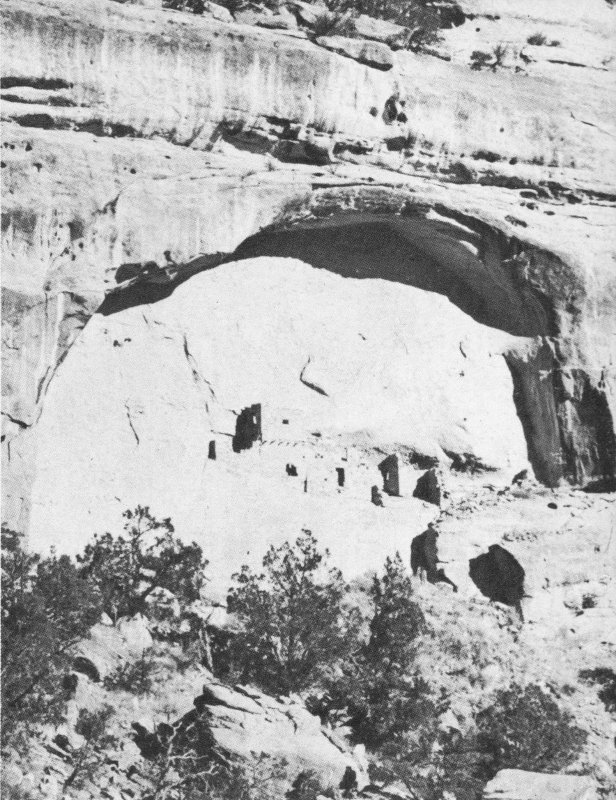
Buzzard House.
Although this ruin has little protection from the elements, several structures are in good condition. It was once a village of about twenty-five rooms with one or more kivas at the foot of the cliff.
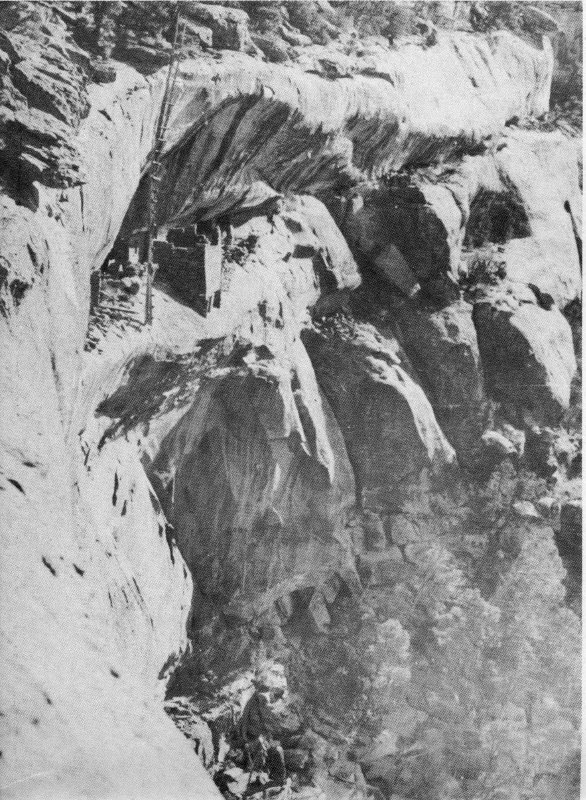
Daniel’s House.
This is one of the highest cliff dwellings of the Mesa Verde. The cowboys were unable to get into it and it was finally entered for the first time by park service men in 1915. A large collection of artifacts was ample indication that the early explorers had not been in the ruin. This probably was the cliff dwelling referred to by John Wetherill when he stated that there was one he and his brothers were never able to reach. The ladder dates from 1915, and is no longer safe for use.
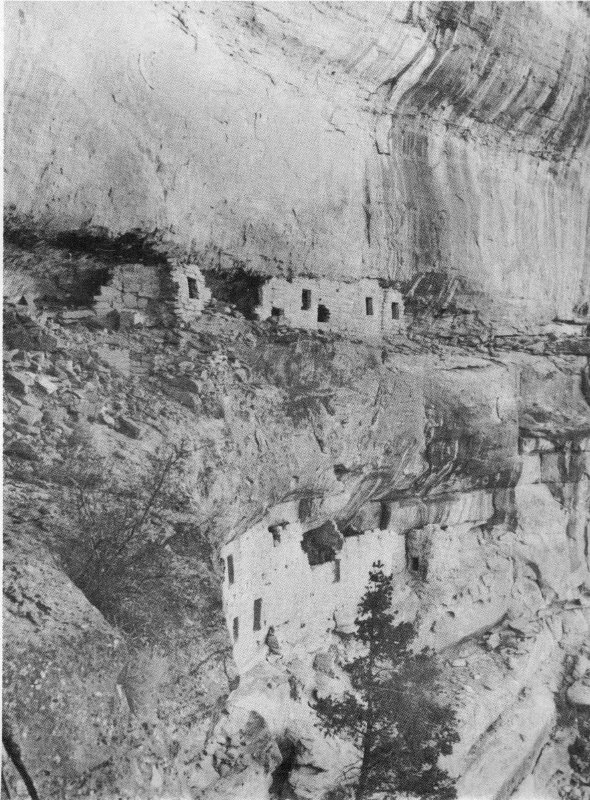
This unnamed cliff dwelling once contained forty or forty-five rooms. It had excellent defensive possibilities for in times of trouble the upper section could have sheltered all the people of the village. Carved inscriptions in this ruin indicate that early explorers entered it as early as 1884.
Below are pictured four cliff dwellings that are typical of the many that contain from six to twenty rooms. Most of the ruins in this group are located high on the cliffs and often are extremely difficult to enter.
As we drop down to the smaller ruins the actual number of ruins increases. In the many canyons of the area almost every cave was utilized by the Indians. There were far more small caves than large ones and as a result there are far more of the smaller cliff dwellings.
It is not even wise to try to estimate the number of cliff dwellings that contain from six to twenty rooms. Certainly it doesn’t take much of a ruin to contain six rooms. No one has the slightest idea how many there may be so we will say hundreds, which means anything from 200 up.
A village of less than twenty rooms did not house many families. It would seem to have been a poor defensive unit for there would have been only a few men in such a village. In most cases the location made up for the small number of defenders. The majority were high in the cliffs and it would not have been too difficult for a handful of men to defend a village that could be entered only by a ladder, a toehold trail, or a rope from the top of the cliff.
Although these villages were small, they were surprisingly well built. Some of the outstanding masonry in the area is to be found in these small, high ruins. Cliff Palace, the largest of the cliff dwellings, contains excellent examples of well-cut stones, sharp straight wall corners, well-built doors and smooth wall plaster. But the finest work in Cliff Palace can be matched in many of the smaller ruins.
In the ruins below it is clearly evident that there was little space for the activities of the people. In most cases the front walls rose from the edge of a sheer cliff and there were no courts and few house roofs, as in the larger cliff dwellings. In most of these small high villages the daily activities were carried on either inside the houses or below the village at the base of the cliff.

This unnamed cliff dwelling is in the far southwestern corner of the park. Originally it contained two kivas and about a dozen rooms.
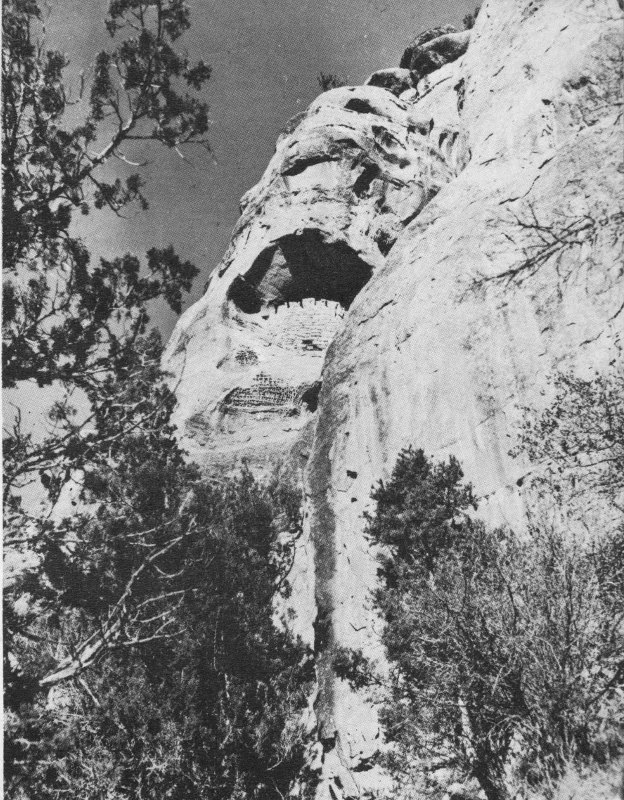
A small high ruin of not more than six rooms. It can be entered only from the top by means of a rope and while it is near park headquarters, it has not been entered in recent times.
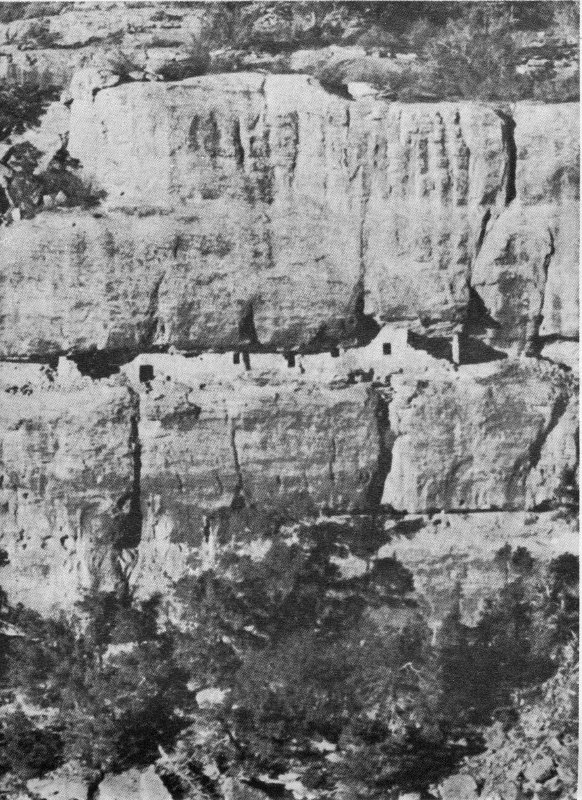
The House of Many Windows.
This ruin of one kiva and about ten rooms is in Cliff Canyon, near Cliff Palace. It has an outstanding defensive position.
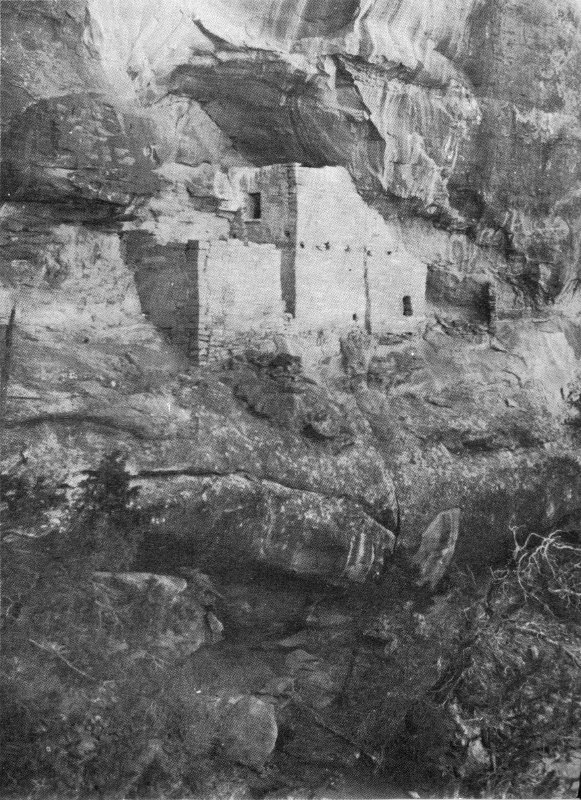
A small unnamed ruin of six rooms. No kiva is in evidence but there may be one somewhere along the base of the cliff.
It has already become obvious that as the size of the ruins diminishes the number increases. An estimate of the number of these tiny ruins would sound unreasonable. It probably is safe to say, however, that there may be as many of these very small ruins as there are of all the others together.
Below are typical examples of the small high ruins that contain from one to five rooms.
All of the canyons have these very small ruins—a count would run into the hundreds. In all probability many have not been entered in modern times for they are so small and high as to be scarcely worth the effort. Probably some have not even been seen by white men. Since they are located on cliff faces often they can be seen only from the opposite canyon wall. And when they are in deep recesses and crevices they can be seen only from certain points and only when light conditions are exactly right.
One cannot view these small ruins without wondering about their intended use. In some cases, of course, they were dwellings. Often they contained from three to five well-built rooms which, even though high on the cliffs would have housed a few people. Life in such villages may have been a bit nerve-wracking but at least the people enjoyed a defensive advantage. Usually these tiny structures did not contain kivas. Often several of the small villages were close together and they may have shared a kiva that was somewhere along the base of the cliff.
Most of these very small ruins contained only one or two rooms and they were often incredibly high on sheer canyon walls. Usually the rooms were small; sometimes there was scarcely room enough for a man to crowd inside. Certainly these were not living rooms for families. And it is doubtful if they were storage rooms for they were often located some distance from other villages. Surely food would not have been stored where it could have been reached by anyone with monkey-like climbing ability and no fear of heights.
Many suggestions have been made about the small high cliff dwellings but each ends with a question mark. Were they homes? Did they serve as storage rooms? Did antisocial individuals live in them? Were they hideouts that resulted from excessive enemy activity? Did daring youngsters build them “just for fun?” Or were they simply the result of a fad—was it considered quite clever to build in breath-taking places?

This cliff dwelling was simply a wall built across the opening of a tiny cave. The space thus enclosed was divided into two small rooms, each with its own door. In spite of the fact that there is little protection from rain and wind the smooth plaster on the front wall is in excellent condition.
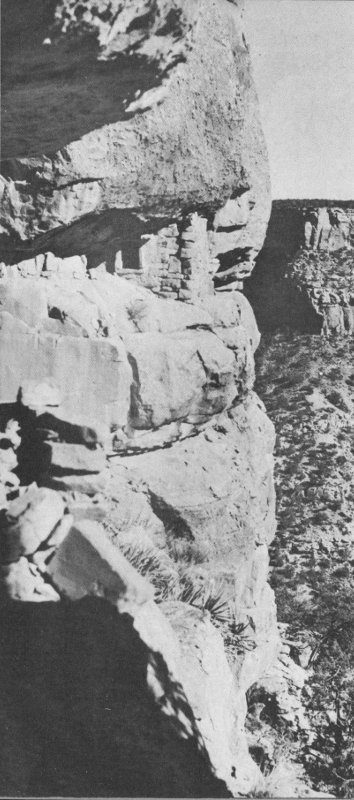
This is typical of the innumerable single room structures that are to be found in the nooks and crannies in the cliffs. The ruin pictured is less than three feet high and the longest dimension is about four feet.
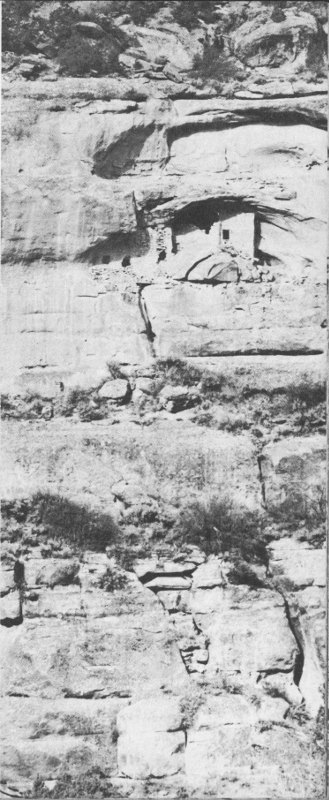
Containing five small but well-built rooms this structure was without doubt a dwelling. There was little space for the activities of the people but the location provided excellent security. With small amounts of food and water in the village the residents probably had little fear of raiders.
Spring House is an example of the large cliff dwellings in which further excavation may produce valuable archeological material and information. As has already been mentioned the early explorers worked extensively in the ruins and removed an amazing amount of material. Ruins like Spring House, however, contain such deep masses of debris that it is possible the cowboys did not do a thorough job of excavation. If the lower section of this cave were excavated valuable material might be found in the deeper levels.
Many centuries before the Pueblo Indians built the cliff dwellings their ancestors lived in the caves of the Mesa Verde region. At first they had no houses and the caves provided shelter. After a time pithouses developed and these structures were sometimes built in the caves. Finally the people deserted the cliffs and as the centuries passed the evidences of the early occupations were covered with earth and sand that accumulated. When the people returned to the cliffs centuries later they built their cliff dwellings on top of the earlier material, not knowing or not caring that it was there.
In order to recover the material left by the earlier people it is necessary to excavate under the cliff dwellings. One project of this type has been carried out and the results are an indication of what further excavation may reveal under some of the larger ruins. In 1926, three pithouses were found in the lower levels of Stephouse Cave, which is across the canyon from Spring House. In 1891, Nordenskiold realized that earlier people had lived in the cave although he did not dig deeply enough to find the pithouses. As he dug into the debris he found two pieces of crude early pottery and in his book Nordenskiold stated, “It is possible that both these vessels are older than the rest of the pottery from the cliff dwellings. Perhaps they are the work of a people who inhabited Stephouse Cave before the erection of the cliff village.”
Later, the Wetherills found more of the early pottery. They even dug through a portion of one of the pithouses and they, too, suggested that an earlier people had lived there. Finally in 1926, Park Superintendent Jesse L. Nusbaum excavated that section of the cave and found the three pithouses under several feet of debris left by the later people who had lived in the cliff dwelling.
If the evidences of the earlier occupations are found in the caves it will be in situations like that pictured on the opposite page where great depths of debris protected them from the early explorers. Little is known of the occupation of the Mesa Verde by the earliest agricultural people. Further knowledge will come only upon excavation of the lower levels of some of the caves.

Spring House, part of which is shown here, was one of the largest of the cliff dwellings. The fragmentary walls in the lower section indicate that structures two or more stories in height once filled this part of the cave. This village probably contained more than 100 rooms. A spring behind the walls at the left end gave the ruin its name.
Two ruins have been found in the Mesa Verde that seem quite different from the rest. All evidence indicates that these structures were not dwellings but were built for some special purpose. When they were excavated, they contained practically nothing that served to indicate their intended use, but because of certain construction features they are thought to have been used for ceremonial purposes.
This large structure stands on the point between Cliff and Fewkes Canyons. While it is not a cliff dwelling it was, without doubt, constructed by people who lived in cliff dwellings nearby. Within one-half mile of Sun Temple are twenty cliff dwellings and it is believed that people from some or all of these may have worked together to construct this large ceremonial building.
Sun Temple is a D-shaped structure, 121 feet long and 64 feet wide. At the time of excavation some of the walls were more than 11 feet in height and originally all of the outer walls probably were a little higher than that. The walls, which contain some of the best masonry in the Mesa Verde, have an average thickness of about three feet. There are no doors in the outer walls and there is no evidence of a roof. The building contains twenty-four rooms, of various shapes, three kivas and a large court. Nine of the rooms have no doors; they were simply deep cells entered from the top.
The most unusual feature of Sun Temple is its evidence of careful planning. It was not built haphazardly, as were the cliff dwellings, but according to a preconceived plan. The main, perhaps the original section, is D-shaped with the parts arranged in almost perfect symmetry. When the second section was added the building retained the D-shape.
Sun Temple is without doubt the most mysterious building that has been found in the Mesa Verde. Because of the evidence of careful planning, the unusual symmetry of its parts, and the complete lack of any evidence that it was a habitation, Sun Temple is considered to have been constructed for special ceremonial usage. The name Sun Temple is misleading, however, for the nature of the ceremonies will never be known.

Sun Temple
This unusual structure is located in a shallow cave in Fewkes Canyon, only a short distance from Sun Temple. Like Sun Temple it exhibits a symmetrical arrangement which indicates careful planning on the part of the builders.
In the center of the open court is a large firepit, on either side of which is a low rectangular crypt. At each end of the court stands a two story structure. Originally most of the walls were covered with a white plaster and on this a number of geometric and animal figures were painted in red.
Few artifacts were found in Fire Temple at the time of excavation and there was no indication that it had been used as a dwelling. Because of this and the symmetrical arrangement it is considered to have been used for ceremonies. The name, Fire Temple, is misleading for there is no possibility of determining the nature of the ceremonies.
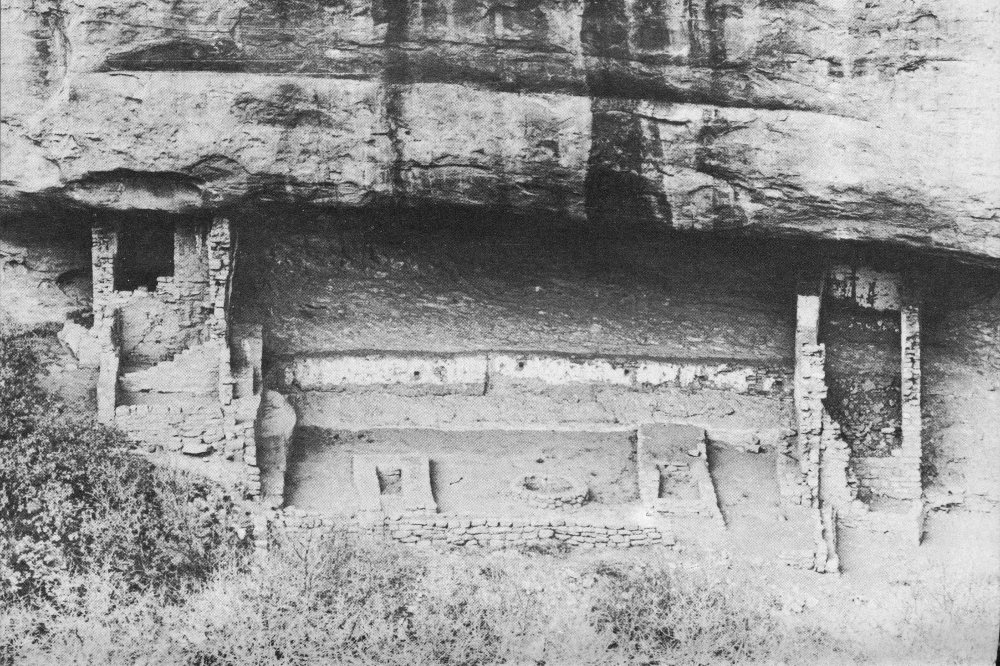
Fire Temple
Cliff Palace occupies a huge crescent-shaped cave on the east side of Cliff Canyon. The cave itself measures 325 feet across the front and its greatest depth is just over 100 feet. The ruin covers the entire floor of the cave and parts of it rise to the cave roof. The ancient builders made no effort to alter the cave to fit their needs. They simply made their structures conform to natural contours and when seen under certain conditions of light the houses seem almost to be part of the cliff itself.
Because of its location visitors are able to get better views of Cliff Palace than of any of the other cliff dwellings. Several points on the opposite rim of the canyon offer striking distant views and the high cliffs at each end of the cave are perfectly located for spectacular closeups.
Seen from any angle Cliff Palace is a magnificent structure and visitors sometimes have difficulty in believing that it is real. Here in the midst of a vast wilderness of canyons is this great ruin, sheltered for seven centuries by the enormous cave. It is a strange setting for the ancient city and it has an unreal quality for visitors who see it for the first time.
Baron Nordenskiold, who saw Cliff Palace in 1891, felt something of this when he told of his first view of the ruin in his book, “The Cliff Dwellers of the Mesa Verde.”
“In a long, but not very deep branch of Cliff Canyon, a wild and gloomy gorge named Cliff Palace Canyon, lies the largest of the ruins on the Mesa Verde, the Cliff Palace. Strange and indescribable is the impression on the traveler, when, after a long and tiring ride through the boundless monotonous pinon forest, he suddenly halts on the brink of the precipice, and in the opposite cliff beholds the ruins of the Cliff Palace, framed in the massive vault of rock above and in a bed of sunlit cedar and pinon trees below. This ruin well deserves its name, for with its round towers and high walls rising out of the heaps of stones deep in the mysterious twilight of the cavern, and defying in their sheltered site the ravages of time, it resembles at a distance an enchanted castle.”

The picture is ample proof that Cliff Palace was the greatest architectural achievement of the Pueblo Indians of the Mesa Verde. Without doubt, this huge ruin, sheltered for seven centuries by its tremendous cave, gives a greater thrill to the person who views it for the first time than any other ruin. Each cliff dwelling has its interesting features but Cliff Palace, with its great size and impressive setting, stirs the imagination more than any of the others.
As you look at Cliff Palace today, it is difficult to see it as it was when it was alive. Many of the walls have fallen and only small bits of masonry remain as indications of houses that once were there. Rebuild these walls in your imagination and then, most important of all, place flat adobe roofs on the houses. Now see how it has changed! It is no longer a ruin—it has become a terraced apartment house, fitted into the sheltering cave. The more than 200 rooms rise in at least eight levels from the front of the cave to the high structures in the rear.
As your imagination restores the village to its original condition the people begin to appear. Since it is evening all of them have returned to the security of their cave home. The men have come back from the fields and from the hunt. The women have returned from their search for roots and berries and the girls have made their last trip to the springs, returning with jars of water balanced on their heads. The children, urged by the calls of their mothers, have ended their play in the canyon and on the cliffs and returned to their homes. Only the dogs and turkeys are outside the village: they are searching for scraps of food on the great trash pile below the cave.
As the shadows lengthen the 300 or 400 inhabitants are safe within the shelter of their fortress-like village. Cooking fires have been kindled and columns of smoke drift lazily up the cliff and into the sky. The odors of corn bread and stewing or roasting meat rise on the evening air and soon the people separate into many small family groups for the evening meal. Now it is quiet: only the murmur of low voices rises from the cave. The day’s activities are over and the happy, contented people are ready for the night.
If you would like really to see the people, scroll down.

In order to feel the real glory of Cliff Palace, see it toward evening when the slanting rays of the setting sun cast a warm glow on its walls. Walk out to the point from which this picture was taken—the high cliff at the north end of the cave. Sit quietly for a time—then let the imagination drift back seven centuries.
Sometimes visitors to the Mesa Verde find it difficult to see the Indians who once lived in the cliff dwellings. It is not always easy for the imagination to carry one back through the centuries to the time when there was life in the caves. Minds geared to the frantic pace of modern times are not always able to see the thousands of Indians who once lived in the cliff dwellings.
In order to make it easier for visitors to see the people, dioramas like the one pictured are displayed in the museum. The ancient villages have been reproduced in miniature. In them are not only the people, engaged in their many activities, but all the things they used in their daily lives. The diorama pictured below is a reproduction of Spruce Tree House, one of the largest of the cliff dwellings. One-half of the thirteenth century village has been reproduced as accurately as possible. In it 50 people are engaged in the various activities that occupied the inhabitants of the village seven centuries ago. The adult human figures are four inches high and all objects are on the same scale.
As one stands in front of this diorama it is no longer necessary to try to imagine the life of ancient times. Here in miniature is a cliff dwelling and its people. Houses and kivas are being built—some of the men work diligently while others sit on the walls and criticize. Some of the men are making tools and weapons—one is telling stories to a group of boys—another has just returned from the hunt with a fat rabbit. Several old men bask in the sun and talk of bygone times when things were better. Some of the women are cooking over flickering fires—others care for tiny babies. Some of the young women are grinding corn while others are returning from the spring with great jars of water on their heads. Children are playing in the courts and one youngster is helping a baby brother take his first toddling steps. Since it is harvest time the products of the farms are being brought to the village. Brightly colored ears of corn are being spread out on the roofs to dry and piles of yellow squashes may be seen in the courts.
Dioramas like this one provide for visitors the most important part of the Mesa Verde Story, the part that is so often missed. The excavated cliff dwellings that visitors enter are empty. Seven centuries ago the Indians themselves walked away, driven to the south by enemies and a great drouth. Most of their belongings were left behind but the early explorers and later archeologists removed them.
Because of this a cliff dwelling may seem, at first glance, to be an empty house. Too often visitors see only the stone walls and fail to see the people who built them. One must always remember that a cliff dwelling is the architectural expression of a settled, industrious agricultural people. For a thousand years they lived in the Mesa Verde region. From a simple beginning their culture developed steadily and the cultural peak was reached during the thirteenth century. This was the century of the cliff dwellings. Because of strong enemy pressure the people moved to the caves and built the cliff dwellings for which the Mesa Verde is famous.
Just before the close of the thirteenth century the story ended. Menaced by their enemies and with their existence threatened by the great drouth of 1276-1299 A.D., they moved to the south and east. Gradually they mingled with other Pueblo Indians and soon were no longer recognizable as a Mesa Verde group. Their descendants are to be found in some of the present-day Indian Pueblos along the Rio Grande, in New Mexico.

The scene pictured is from a diorama in the Mesa Verde Museum. In this carefully reproduced cliff dwelling the former inhabitants carry on the many activities of their daily lives.
LITHOPRINTED IN THE UNITED STATES OF AMERICA BY
CUSHING-MALLOY, INC., ANN ARBOR, MICHIGAN, 1954
End of Project Gutenberg's Cliff Dwellings of the Mesa Verde, by Don Watson
*** END OF THIS PROJECT GUTENBERG EBOOK CLIFF DWELLINGS OF THE MESA VERDE ***
***** This file should be named 57422-h.htm or 57422-h.zip *****
This and all associated files of various formats will be found in:
http://www.gutenberg.org/5/7/4/2/57422/
Produced by Stephen Hutcheson and the Online Distributed
Proofreading Team at http://www.pgdp.net
Updated editions will replace the previous one--the old editions will
be renamed.
Creating the works from print editions not protected by U.S. copyright
law means that no one owns a United States copyright in these works,
so the Foundation (and you!) can copy and distribute it in the United
States without permission and without paying copyright
royalties. Special rules, set forth in the General Terms of Use part
of this license, apply to copying and distributing Project
Gutenberg-tm electronic works to protect the PROJECT GUTENBERG-tm
concept and trademark. Project Gutenberg is a registered trademark,
and may not be used if you charge for the eBooks, unless you receive
specific permission. If you do not charge anything for copies of this
eBook, complying with the rules is very easy. You may use this eBook
for nearly any purpose such as creation of derivative works, reports,
performances and research. They may be modified and printed and given
away--you may do practically ANYTHING in the United States with eBooks
not protected by U.S. copyright law. Redistribution is subject to the
trademark license, especially commercial redistribution.
START: FULL LICENSE
THE FULL PROJECT GUTENBERG LICENSE
PLEASE READ THIS BEFORE YOU DISTRIBUTE OR USE THIS WORK
To protect the Project Gutenberg-tm mission of promoting the free
distribution of electronic works, by using or distributing this work
(or any other work associated in any way with the phrase "Project
Gutenberg"), you agree to comply with all the terms of the Full
Project Gutenberg-tm License available with this file or online at
www.gutenberg.org/license.
Section 1. General Terms of Use and Redistributing Project
Gutenberg-tm electronic works
1.A. By reading or using any part of this Project Gutenberg-tm
electronic work, you indicate that you have read, understand, agree to
and accept all the terms of this license and intellectual property
(trademark/copyright) agreement. If you do not agree to abide by all
the terms of this agreement, you must cease using and return or
destroy all copies of Project Gutenberg-tm electronic works in your
possession. If you paid a fee for obtaining a copy of or access to a
Project Gutenberg-tm electronic work and you do not agree to be bound
by the terms of this agreement, you may obtain a refund from the
person or entity to whom you paid the fee as set forth in paragraph
1.E.8.
1.B. "Project Gutenberg" is a registered trademark. It may only be
used on or associated in any way with an electronic work by people who
agree to be bound by the terms of this agreement. There are a few
things that you can do with most Project Gutenberg-tm electronic works
even without complying with the full terms of this agreement. See
paragraph 1.C below. There are a lot of things you can do with Project
Gutenberg-tm electronic works if you follow the terms of this
agreement and help preserve free future access to Project Gutenberg-tm
electronic works. See paragraph 1.E below.
1.C. The Project Gutenberg Literary Archive Foundation ("the
Foundation" or PGLAF), owns a compilation copyright in the collection
of Project Gutenberg-tm electronic works. Nearly all the individual
works in the collection are in the public domain in the United
States. If an individual work is unprotected by copyright law in the
United States and you are located in the United States, we do not
claim a right to prevent you from copying, distributing, performing,
displaying or creating derivative works based on the work as long as
all references to Project Gutenberg are removed. Of course, we hope
that you will support the Project Gutenberg-tm mission of promoting
free access to electronic works by freely sharing Project Gutenberg-tm
works in compliance with the terms of this agreement for keeping the
Project Gutenberg-tm name associated with the work. You can easily
comply with the terms of this agreement by keeping this work in the
same format with its attached full Project Gutenberg-tm License when
you share it without charge with others.
1.D. The copyright laws of the place where you are located also govern
what you can do with this work. Copyright laws in most countries are
in a constant state of change. If you are outside the United States,
check the laws of your country in addition to the terms of this
agreement before downloading, copying, displaying, performing,
distributing or creating derivative works based on this work or any
other Project Gutenberg-tm work. The Foundation makes no
representations concerning the copyright status of any work in any
country outside the United States.
1.E. Unless you have removed all references to Project Gutenberg:
1.E.1. The following sentence, with active links to, or other
immediate access to, the full Project Gutenberg-tm License must appear
prominently whenever any copy of a Project Gutenberg-tm work (any work
on which the phrase "Project Gutenberg" appears, or with which the
phrase "Project Gutenberg" is associated) is accessed, displayed,
performed, viewed, copied or distributed:
This eBook is for the use of anyone anywhere in the United States and
most other parts of the world at no cost and with almost no
restrictions whatsoever. You may copy it, give it away or re-use it
under the terms of the Project Gutenberg License included with this
eBook or online at www.gutenberg.org. If you are not located in the
United States, you'll have to check the laws of the country where you
are located before using this ebook.
1.E.2. If an individual Project Gutenberg-tm electronic work is
derived from texts not protected by U.S. copyright law (does not
contain a notice indicating that it is posted with permission of the
copyright holder), the work can be copied and distributed to anyone in
the United States without paying any fees or charges. If you are
redistributing or providing access to a work with the phrase "Project
Gutenberg" associated with or appearing on the work, you must comply
either with the requirements of paragraphs 1.E.1 through 1.E.7 or
obtain permission for the use of the work and the Project Gutenberg-tm
trademark as set forth in paragraphs 1.E.8 or 1.E.9.
1.E.3. If an individual Project Gutenberg-tm electronic work is posted
with the permission of the copyright holder, your use and distribution
must comply with both paragraphs 1.E.1 through 1.E.7 and any
additional terms imposed by the copyright holder. Additional terms
will be linked to the Project Gutenberg-tm License for all works
posted with the permission of the copyright holder found at the
beginning of this work.
1.E.4. Do not unlink or detach or remove the full Project Gutenberg-tm
License terms from this work, or any files containing a part of this
work or any other work associated with Project Gutenberg-tm.
1.E.5. Do not copy, display, perform, distribute or redistribute this
electronic work, or any part of this electronic work, without
prominently displaying the sentence set forth in paragraph 1.E.1 with
active links or immediate access to the full terms of the Project
Gutenberg-tm License.
1.E.6. You may convert to and distribute this work in any binary,
compressed, marked up, nonproprietary or proprietary form, including
any word processing or hypertext form. However, if you provide access
to or distribute copies of a Project Gutenberg-tm work in a format
other than "Plain Vanilla ASCII" or other format used in the official
version posted on the official Project Gutenberg-tm web site
(www.gutenberg.org), you must, at no additional cost, fee or expense
to the user, provide a copy, a means of exporting a copy, or a means
of obtaining a copy upon request, of the work in its original "Plain
Vanilla ASCII" or other form. Any alternate format must include the
full Project Gutenberg-tm License as specified in paragraph 1.E.1.
1.E.7. Do not charge a fee for access to, viewing, displaying,
performing, copying or distributing any Project Gutenberg-tm works
unless you comply with paragraph 1.E.8 or 1.E.9.
1.E.8. You may charge a reasonable fee for copies of or providing
access to or distributing Project Gutenberg-tm electronic works
provided that
* You pay a royalty fee of 20% of the gross profits you derive from
the use of Project Gutenberg-tm works calculated using the method
you already use to calculate your applicable taxes. The fee is owed
to the owner of the Project Gutenberg-tm trademark, but he has
agreed to donate royalties under this paragraph to the Project
Gutenberg Literary Archive Foundation. Royalty payments must be paid
within 60 days following each date on which you prepare (or are
legally required to prepare) your periodic tax returns. Royalty
payments should be clearly marked as such and sent to the Project
Gutenberg Literary Archive Foundation at the address specified in
Section 4, "Information about donations to the Project Gutenberg
Literary Archive Foundation."
* You provide a full refund of any money paid by a user who notifies
you in writing (or by e-mail) within 30 days of receipt that s/he
does not agree to the terms of the full Project Gutenberg-tm
License. You must require such a user to return or destroy all
copies of the works possessed in a physical medium and discontinue
all use of and all access to other copies of Project Gutenberg-tm
works.
* You provide, in accordance with paragraph 1.F.3, a full refund of
any money paid for a work or a replacement copy, if a defect in the
electronic work is discovered and reported to you within 90 days of
receipt of the work.
* You comply with all other terms of this agreement for free
distribution of Project Gutenberg-tm works.
1.E.9. If you wish to charge a fee or distribute a Project
Gutenberg-tm electronic work or group of works on different terms than
are set forth in this agreement, you must obtain permission in writing
from both the Project Gutenberg Literary Archive Foundation and The
Project Gutenberg Trademark LLC, the owner of the Project Gutenberg-tm
trademark. Contact the Foundation as set forth in Section 3 below.
1.F.
1.F.1. Project Gutenberg volunteers and employees expend considerable
effort to identify, do copyright research on, transcribe and proofread
works not protected by U.S. copyright law in creating the Project
Gutenberg-tm collection. Despite these efforts, Project Gutenberg-tm
electronic works, and the medium on which they may be stored, may
contain "Defects," such as, but not limited to, incomplete, inaccurate
or corrupt data, transcription errors, a copyright or other
intellectual property infringement, a defective or damaged disk or
other medium, a computer virus, or computer codes that damage or
cannot be read by your equipment.
1.F.2. LIMITED WARRANTY, DISCLAIMER OF DAMAGES - Except for the "Right
of Replacement or Refund" described in paragraph 1.F.3, the Project
Gutenberg Literary Archive Foundation, the owner of the Project
Gutenberg-tm trademark, and any other party distributing a Project
Gutenberg-tm electronic work under this agreement, disclaim all
liability to you for damages, costs and expenses, including legal
fees. YOU AGREE THAT YOU HAVE NO REMEDIES FOR NEGLIGENCE, STRICT
LIABILITY, BREACH OF WARRANTY OR BREACH OF CONTRACT EXCEPT THOSE
PROVIDED IN PARAGRAPH 1.F.3. YOU AGREE THAT THE FOUNDATION, THE
TRADEMARK OWNER, AND ANY DISTRIBUTOR UNDER THIS AGREEMENT WILL NOT BE
LIABLE TO YOU FOR ACTUAL, DIRECT, INDIRECT, CONSEQUENTIAL, PUNITIVE OR
INCIDENTAL DAMAGES EVEN IF YOU GIVE NOTICE OF THE POSSIBILITY OF SUCH
DAMAGE.
1.F.3. LIMITED RIGHT OF REPLACEMENT OR REFUND - If you discover a
defect in this electronic work within 90 days of receiving it, you can
receive a refund of the money (if any) you paid for it by sending a
written explanation to the person you received the work from. If you
received the work on a physical medium, you must return the medium
with your written explanation. The person or entity that provided you
with the defective work may elect to provide a replacement copy in
lieu of a refund. If you received the work electronically, the person
or entity providing it to you may choose to give you a second
opportunity to receive the work electronically in lieu of a refund. If
the second copy is also defective, you may demand a refund in writing
without further opportunities to fix the problem.
1.F.4. Except for the limited right of replacement or refund set forth
in paragraph 1.F.3, this work is provided to you 'AS-IS', WITH NO
OTHER WARRANTIES OF ANY KIND, EXPRESS OR IMPLIED, INCLUDING BUT NOT
LIMITED TO WARRANTIES OF MERCHANTABILITY OR FITNESS FOR ANY PURPOSE.
1.F.5. Some states do not allow disclaimers of certain implied
warranties or the exclusion or limitation of certain types of
damages. If any disclaimer or limitation set forth in this agreement
violates the law of the state applicable to this agreement, the
agreement shall be interpreted to make the maximum disclaimer or
limitation permitted by the applicable state law. The invalidity or
unenforceability of any provision of this agreement shall not void the
remaining provisions.
1.F.6. INDEMNITY - You agree to indemnify and hold the Foundation, the
trademark owner, any agent or employee of the Foundation, anyone
providing copies of Project Gutenberg-tm electronic works in
accordance with this agreement, and any volunteers associated with the
production, promotion and distribution of Project Gutenberg-tm
electronic works, harmless from all liability, costs and expenses,
including legal fees, that arise directly or indirectly from any of
the following which you do or cause to occur: (a) distribution of this
or any Project Gutenberg-tm work, (b) alteration, modification, or
additions or deletions to any Project Gutenberg-tm work, and (c) any
Defect you cause.
Section 2. Information about the Mission of Project Gutenberg-tm
Project Gutenberg-tm is synonymous with the free distribution of
electronic works in formats readable by the widest variety of
computers including obsolete, old, middle-aged and new computers. It
exists because of the efforts of hundreds of volunteers and donations
from people in all walks of life.
Volunteers and financial support to provide volunteers with the
assistance they need are critical to reaching Project Gutenberg-tm's
goals and ensuring that the Project Gutenberg-tm collection will
remain freely available for generations to come. In 2001, the Project
Gutenberg Literary Archive Foundation was created to provide a secure
and permanent future for Project Gutenberg-tm and future
generations. To learn more about the Project Gutenberg Literary
Archive Foundation and how your efforts and donations can help, see
Sections 3 and 4 and the Foundation information page at
www.gutenberg.org Section 3. Information about the Project Gutenberg
Literary Archive Foundation
The Project Gutenberg Literary Archive Foundation is a non profit
501(c)(3) educational corporation organized under the laws of the
state of Mississippi and granted tax exempt status by the Internal
Revenue Service. The Foundation's EIN or federal tax identification
number is 64-6221541. Contributions to the Project Gutenberg Literary
Archive Foundation are tax deductible to the full extent permitted by
U.S. federal laws and your state's laws.
The Foundation's principal office is in Fairbanks, Alaska, with the
mailing address: PO Box 750175, Fairbanks, AK 99775, but its
volunteers and employees are scattered throughout numerous
locations. Its business office is located at 809 North 1500 West, Salt
Lake City, UT 84116, (801) 596-1887. Email contact links and up to
date contact information can be found at the Foundation's web site and
official page at www.gutenberg.org/contact
For additional contact information:
Dr. Gregory B. Newby
Chief Executive and Director
[email protected]
Section 4. Information about Donations to the Project Gutenberg
Literary Archive Foundation
Project Gutenberg-tm depends upon and cannot survive without wide
spread public support and donations to carry out its mission of
increasing the number of public domain and licensed works that can be
freely distributed in machine readable form accessible by the widest
array of equipment including outdated equipment. Many small donations
($1 to $5,000) are particularly important to maintaining tax exempt
status with the IRS.
The Foundation is committed to complying with the laws regulating
charities and charitable donations in all 50 states of the United
States. Compliance requirements are not uniform and it takes a
considerable effort, much paperwork and many fees to meet and keep up
with these requirements. We do not solicit donations in locations
where we have not received written confirmation of compliance. To SEND
DONATIONS or determine the status of compliance for any particular
state visit www.gutenberg.org/donate
While we cannot and do not solicit contributions from states where we
have not met the solicitation requirements, we know of no prohibition
against accepting unsolicited donations from donors in such states who
approach us with offers to donate.
International donations are gratefully accepted, but we cannot make
any statements concerning tax treatment of donations received from
outside the United States. U.S. laws alone swamp our small staff.
Please check the Project Gutenberg Web pages for current donation
methods and addresses. Donations are accepted in a number of other
ways including checks, online payments and credit card donations. To
donate, please visit: www.gutenberg.org/donate
Section 5. General Information About Project Gutenberg-tm electronic works.
Professor Michael S. Hart was the originator of the Project
Gutenberg-tm concept of a library of electronic works that could be
freely shared with anyone. For forty years, he produced and
distributed Project Gutenberg-tm eBooks with only a loose network of
volunteer support.
Project Gutenberg-tm eBooks are often created from several printed
editions, all of which are confirmed as not protected by copyright in
the U.S. unless a copyright notice is included. Thus, we do not
necessarily keep eBooks in compliance with any particular paper
edition.
Most people start at our Web site which has the main PG search
facility: www.gutenberg.org
This Web site includes information about Project Gutenberg-tm,
including how to make donations to the Project Gutenberg Literary
Archive Foundation, how to help produce our new eBooks, and how to
subscribe to our email newsletter to hear about new eBooks.